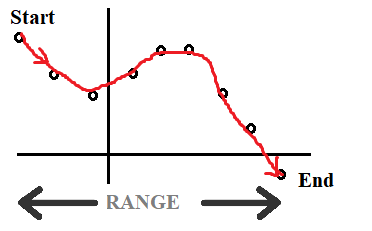

Returns value clamped to the inclusive range of min and max. Overloads Clamp(UIntPtr, UIntPtr, UIntPtr)

Microsoft makes no warranties, express or implied, with respect to the information provided here.
Range math code#
This code is an example of a simple Java program that uses the Math.random() method to generate a random floating-point number and print it to the console.Some information relates to prerelease product that may be substantially modified before it’s released. The Domain and Range Calculator finds all possible x and y values for a. To understand Math.random() better, let’s look at some examples, Step 1: Enter the formula for which you want to calculate the domain and range.

There are no parameters to the Math.random() function Java Math.random() Example If the domain is not all real numbers, then it must be restricted. It returns a pseudorandom double value greater than or equal to 0.0 and less than 1.0 Parameters a measure of spread equal to the upper quartile (Q3) minus the lower quartile (Q1) in a data set. The returned value of Math.random() can be used in a variety of ways, such as generating random numbers within a specific range, shuffling arrays, and more. Call Now (888) 736-0920 Hotmath Home Domain and Range The domain of a function f ( x) is the set of all values for which the function is defined, and the range of the function is the set of all values that f takes. However, the default seed is based on the current time, which makes the generated numbers appear random. The origin of the word Range in mathematics is unknown, but a few early uses of the. The range () function returns a sequence of numbers, starting from 0 by default, and increments by 1 (by default), and stops before a specified number. The Math.random() method generates a pseudo-random number using a deterministic algorithm, meaning that the sequence of numbers generated will be the same if the same seed is used. The range rule of thumb, interquartile range, issues and problems. The Math.random() method in Java is a static method in the class that returns a random floating-point number between 0.0 (inclusive) and 1.0 (exclusive). It is impossible to guess the future value based on current and past values.The generated values are uniformly distributed over a definite interval. In mathematical terms, given a function f(x), the values that f(x) can take on constitute the range of the function, while all the possible x values.It satisfies the following two conditions: Random numbers are numbers that use a large set of numbers and select a single number from them using a mathematical algorithm. Disadvantages of using Math.random() in Java.Advantages of using Math.random() in Java.
Range math how to#
In this blog, we will discuss the basics of the Math.random() method and how to use it in Java to generate random numbers. It is optimized to generate random numbers quickly, making it an ideal choice for high-performance applications where speed is a concern. It can be used to quickly generate random numbers within a specified range, making it a popular choice.Īnother advantage of Math.random() is its performance. One of the main benefits of the Math.random() method is its ease of use. The Math.random() method in Java is a built-in function which is a part of the java.Math class.


 0 kommentar(er)
0 kommentar(er)
